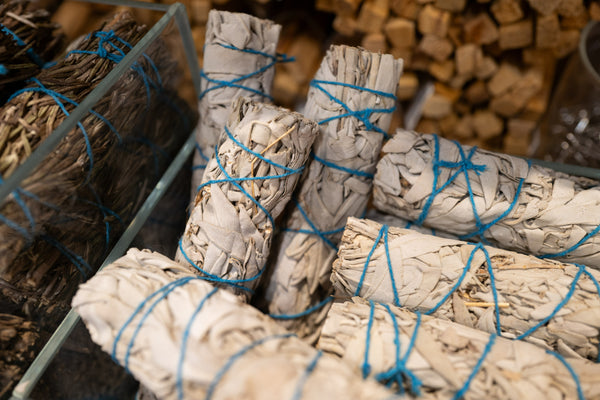
The Legend of the Worry Dolls
Shamans MarketWorry Dolls are tiny, hand-crafted dolls from Guatemala. The dolls are clothed in traditional Mayan costumes and stand one-half to 2 inches tall. Guatemalan artisans bind pieces of wood together or twist together short lengths of wire to create a frame and fashion a torso, legs, arms, and head. By winding cloth and yarn around the frame, the artisans give the doll shape. They use scraps of traditional woven fabric to make the doll costumes and wind more yarn to create the head, hair, feet and hands. Sometimes, they add a tiny woven basket or other traditional implements. Finally, they place a set of 6-12 dolls in tiny wooden boxes or cloth pouches for sale.
The indigenous people from the Highlands in Guatemala created Worry Dolls many generations ago as a remedy for worrying. According to the Mayan legend, when worrying keeps a person awake, he or she tells a worry to as many dolls as necessary. Then the worrier places the dolls under his or her pillow. The dolls take over the worrying for the person who then sleeps peacefully through the night. When morning breaks, the person awakens without the worries that the dolls took away during the night. A variation of the legend instructs a person to tell the dolls her worries then place them in their cloth pouch or wooden box before going to bed.
Shamans Market offers these dolls in several variations, including, the tiny ones in a pouch or box and the larger 2” in sets of 12 alone or in a traditional Guatemalan drawstring pouch.
The Story of the Worry Doll
In the hills outside a small city, lived an old man with his daughter, Flora, and her two children, Maria and Diego. Like most Guatemalan people they had no electricity and no running water. They lived together in a small, one room thatched hut of mud and wood. The home was heated with a large fire in the middle of the room. Grandfather had taught them all to be excellent farmers just like their Mayan ancestors. This year was very bad, as a drought had prevented most of the crops from growing. Even though the ancient Mayans had developed methods of building giant underground storage tanks to hold water just in case of drought, this farm had none. Despite being very poor, the family was usually happy. They all worked very hard and they were thankful for the colorful clothes that Flora was able to make them. The children enjoyed and learned much from their grandfather’s stories. They all worked together to survive.
They would all wake up with the Sun and tend to the fields, just in case it rained. Then they would spend time gathering lots of firewood. Maria and Diego would then go to school for the day. It was hard for them because the teacher taught in Spanish which was not what they spoke at home. Some of their friends were there, but several of them didn’t go to school because they needed to stay home and help their parents.
Because of the drought, it was very hard to gather enough food for the day. For dinner, the children would grind some maize and Mom would use it to make tortillas for the family. It wasn’t much, and it didn’t prevent them from getting hungry the next day. After dinner, when the chores were done, Mother would go back to weaving and the children would kiss the hands of Grandfather and bow to him as they asked him to tell one of his stories. As grandfather told his story they would lay back in their hammocks and listen.
Grandfather’s stories were the best because they were true. His stories had been handed down word by word from his grandfather and his grandfather’s grandfather. Diego had already heard the stories enough to repeat them, but he would have to wait until he had children who wanted to hear them. They listened proudly to their heritage as grandfather described how the ancients had mapped the stars long before anyone else in the world. They were captivated by hearing that their ancestors had developed mathematics long before anyone else in the world. The Mayans developed the concept of zero being a number. The Mayans had a system based on 20 as opposed to the modern system of 10. Maria liked the way grandfather would count to twenty by wiggling her ten fingers then her ten toes.
Best of all was when grandfather would describe the silly things. They giggled out loud as he would describe people tying boards to youngster’s foreheads because they believed a flat forehead to be a sign of beauty. Diego almost fell out of his hammock as he laughed at his grandfather acting out how the ancients used to hang a bead of wax in front of their baby’s eyes in order to make the child cross eyed. They thought it was another sign of beauty.
As sleep was almost near for his grandchildren, grandfather would describe how the ancient Mayans would perform sacrifices or bloodletting as an offering to any one of their 166 gods. At this point in the story, Maria would always reach up and shake Diego’s hammock to try and scare him. It always worked. The scream was also a signal to mom that it was time to put the weaving away and go to sleep. Flora put all her wonderful cloth into a basket underneath her son’s hammock and went to bed.
While sleeping, Maria dreamed of flying with a Quetzal, a long tailed bird which is the national bird of Guatemala. In ancient times the bird was thought to be a spiritual protector of the chiefs and it was a capital offense, punishable by death to kill one. Diego heard Maria making bird noises in her sleep and looked over the edge of his hammock to make fun of her. He was immediately startled by the outline of a thief grabbing his mother’s cloth and running out of the house. “A — A ROBBER!” Diego screamed. His mother and grandfather woke up startled. “Where?” Maria asked. “He just ran out with all mother’s cloth!” Sure enough, the cloth was gone. Flora began to cry, “That was two season’s worth of work! Now I’ll have nothing to sell at the market!” Flora sobbed the rest of the night.
>When the children were leaving for school the next day, Mother was still laying in her hammock and was coming down with a fever. Grandfather would stay with her. When the children returned from school in the afternoon, mother’s fever was worse and they were nearly out of food. Maria said, “Diego we need to help! I have an idea.”
Maria looked in the basket mother kept her cloth in. She was looking for anything that might be left. All that remained in the basket were several scraps of cloth in odd colors and odd shapes. Maria took the basket outside and dragged her brother along. “Go collect small twigs and bring them here,” she asked him. Diego whined and said “Wwwhhhy?” “We have to help mother.” Maria replied. He scampered off to go find twigs without another word. Maria began organizing scraps of cloth, sorting them by color and size. When Diego returned with the twigs, they both started working. When mother or grandfather asked what they were doing, they said it was a secret. Mother was still running a fever and grandfather was trying to make her feel better. The kids kept working.
Late in the night, they ran out of cloth scraps. When they looked at what they had made, they saw dozens of little tiny dolls in little tiny clothes. They had also made little pouches for the dolls to sleep in. As they packaged the dolls up, six in a pouch, Maria remembered one of grandfather’s stories about a magical doll who would grant its owner several wishes. The thought that these dolls were magical was funny to Maria, but for some reason she actually felt it was true. She hoped for her family’s sake that they were magical.
Maria selected her favorite colored pouch and pulled each of the dolls from it. She lined them up in the palm of her hand and began speaking to them. “Good night my tiny friends, my family is in trouble and we need your help. Our fields are dried up, my mother is sick, we have no food or money, and my mother’s cloth was stolen. We need your help little ones.” Maria placed the dolls back in the pouch then placed them under her pillow. She was able to sleep very soundly that night, and when she awoke, the dolls were out of the pouch and all laid out in a circle on the table.
“I was certain I put them in the pouch under my pillow last night,” she said to herself.
Wiping the sleep from her eyes, she convinced herself she must have imagined putting them under her pillow. That morning, Maria and Diego prepared to go to the market. They put all the doll pouches into a large wrap that can be used as a bag or a head covering and began walking to market. Mother managed to get out of her hammock and said, “Where are you going?
They replied, “To market.”
While Mother puzzled over what they would do there, Grandfather wished them good luck.
As Maria and Diego made the long walk to market they encountered many people. They made sure to say “Hi how are you?” It would be considered rude to not say hello. The people would reply,”Fine thank you.” The two of them walked along barefoot, without complaining. Secretly they both wished they had the sandals that many other people used for long walks, but they knew they could not afford that luxury.
Maria’s thoughts turned to bargaining. She had seen her mother and grandfather do it, but she had never had to do it herself. It was expected at the market that people would barter for a fair price. She worried that she would not have the skills needed to barter. Even if she could, what was a fair price for little dolls? She had never seen anyone sell them before. She decided to make up a price as she was bartering. For now, she focused on getting a good spot at the market. A good location would make all the difference she thought to herself. She did find a good spot, it was at the end of an aisle right next to a shoe seller.
As they laid out their dolls on the sidewalk, the shoe seller recognized them and asked them where their mother was with her beautiful cloth. They told him of what had happened. Then Maria informed him that all they had to sell today were these dolls. The shoe seller examined the tiny dolls and puzzled over why someone would want such small dolls. Maria piped up and said there was magic in the dolls. The shoe seller laughed and said there was magic in his shoes too but that wouldn’t help them sell.
“We shall see” said Maria, “we shall see.”
As the day dragged on, sales were not going well, the market was almost closing for the day and they hadn’t sold any dolls. They were both getting worried. As Maria began putting away her dolls, a man dressed in fine clothes and a large hat in a very soft slow vice that is typical of Guatemalans asked “What are you selling?”
“Just these little dolls,” Diego said.
“Magic Dolls!” chimed Maria.
The man adjusted his hat and with a smirk said “Magic huh? I could use a little magic. I’ll take them all!”
They hurriedly wrapped up the dolls and he handed them a wad of money.
“Thank you.” said Maria.
The stranger said, “You’re welcome,” and was gone before Maria could turn around and start bartering for how much change he would get back. She counted the money in disbelief. 6,600quetzals! (~$940) That’s enough for us to live on for a year she exclaimed! She was not exaggerating.
Diego started jumping up and down at the thought of being able to eat tonight. He and Maria bought some food and then headed for home. As they walked, they chewed on chicle which is a natural gum that comes from tree sap (and that’s where Chiclets gum came from).
“Yes we did, we sold dolls!” Diego screamed.
“Magic Dolls,” Maria added.
They explained everything to mother and grandfather.
Mother said, “It doesn’t sound like magic, it sounds like my children worked very hard.”
“But how do you explain that you are feeling better?” asked grandfather.
“That’s just the way trouble is,” exclaimed Flora, “sometimes it just comes and goes.”
“How do you explain the rain?” yelled Diego. “What rain?” they all asked.
“THAT rain,” he pointed. Sure enough, the fields were getting rained on as they were talking. The drought was over.
When Maria was getting ready for bed she noticed something in her pocket, when she pulled it out, it was the same pouch of dolls she had spoken to the night before. How had they gotten there? She was sure she sold them to the man.
In the pouch she found a tiny little note that said, “Tell these dolls your secret wishes. Tell them your problems. Tell them your dreams. And when you awake, you may find the magic within you to make your dreams come true.”
There was no name on the note, just a little drawing of a man in a big hat. The mysterious stranger.
1. Source: www.tc.umn.edu/~mcdo0151/legend.html and http://www.sciencejoywagon.com/kwirt/
The post THE LEGEND OF THE WORRY DOLLS appeared first on Shamans Market .




